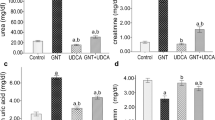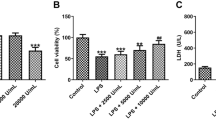Abstract
Urinary tract infections (UTIs) are often caused by Escherichia coli (E. coli). Previous studies have demonstrated that up-regulation of heme oxygenase-1 (HO-1) may trigger a survival mechanism against renal cell death induced by E. coli toxins. The present study analyses the role of carbon monoxide (CO), an end product of HO-1, in the survival mechanism. Moreover, we identified hemolysin as a putative pro-apoptotic toxin in the E. coli supernatant. Tubular cells were incubated with CO in the presence or absence of E. coli toxins. Uropathogenic or transformants of non-pathogenic strains expressing hemolysin were used. We found that the survival pathway during E. coli infection might be activated by HO-1-derived production of CO. The protection by CO was also associated with up-regulation of p21 protein expression. Furthermore, we found that in children with pyelonephritis, all the E. coli strains expressing hemolysin induced apoptosis. In E. coli strains not expressing hemolysin, only 45% of the strains could induce apoptosis. In conclusion, generation of CO elicited by HO-1 could promote survival signaling in renal cells. Hemolysin is one of the secreted toxins that are involved in inducing apoptosis during UTI.






Similar content being viewed by others
References
Hansson SUJ (1999) Urinary tract infection, in pediatric nephrology. In: Barrat EA, Harmon W (eds) Urinary tract infection, in pediatric nephrology. Lippincott, Baltimore, pp 835–850
Yang B, Johnson TS, Thomas GL, Watson PF, Wagner B, Skill NJ, Haylor JL, El Nahas AM (2001) Expression of apoptosis-related genes and proteins in experimental chronic renal scarring. J Am Soc Nephrol 12:275–288
Ortiz A (2000) Renal cell loss through cell suicide. Kidney Int 58:2235–2236
Ortiz A, Lorz C, Justo P, Catalan MP, Egido J (2001) Contribution of apoptotic cell death to renal injury. J Cell Mol Med 5:18–32
Qiu LQ, Sinniah R, Hsu SI (2004) Coupled induction of iNOS and p53 upregulation in renal resident cells may be linked with apoptotic activity in the pathogenesis of progressive IgA nephropathy. J Am Soc Nephrol 15:2066–2078
Wink DA, Hanbauer I, Krishna MC, DeGraff W, Gamson J, Mitchell JB (1993) Nitric oxide protects against cellular damage and cytotoxicity from reactive oxygen species. Proc Natl Acad Sci USA 90:9813–9817
Chen M, Bao W, Aizman R, Huang P, Aspevall O, Gustafsson LE, Ceccatelli S, Celsi G (2004) Activation of extracellular signal-regulated kinase mediates apoptosis induced by uropathogenic Escherichia coli toxins via nitric oxide synthase: protective role of heme oxygenase-1. J Infect Dis 190:127–135
Maines MD (1997) The heme oxygenase system: a regulator of second messenger gases. Annu Rev Pharmacol Toxicol 37:517–554
Platt JL, Nath KA (1998) Heme oxygenase: protective gene or Trojan horse. Nat Med 4:1364–1365
Thom SR, Fisher D, Xu YA, Notarfrancesco K, Ischiropoulos H (2000) Adaptive responses and apoptosis in endothelial cells exposed to carbon monoxide. Proc Natl Acad Sci USA 97:1305–1310
Song R, Kubo M, Morse D, Zhou Z, Zhang X, Dauber JH, Fabisiak J, Alber SM, Watkins SC, Zuckerbraun BS, Otterbein LE, Ning W, Oury TD, Lee PJ, McCurry KR, Choi AM (2003) Carbon monoxide induces cytoprotection in rat orthotopic lung transplantation via anti-inflammatory and anti-apoptotic effects. Am J Pathol 163:231–242
Sass G, Soares MC, Yamashita K, Seyfried S, Zimmermann WH, Eschenhagen T, Kaczmarek E, Ritter T, Volk HD, Tiegs G (2003) Heme oxygenase-1 and its reaction product, carbon monoxide, prevent inflammation-related apoptotic liver damage in mice. Hepatology 38:909–918
Liu H, Mount DB, Nasjletti A, Wang W (1999) Carbon monoxide stimulates the apical 70-pS K+ channel of the rat thick ascending limb. J Clin Invest 103:963–970
O’Donaughy TL, Walker BR (2000) Renal vasodilatory influence of endogenous carbon monoxide in chronically hypoxic rats. Am J Physiol Heart Circ Physiol 279:H2908–2915
Lory S (1998) Secretion of proteins and assembly of bacterial surface organelles: shared pathways of extracellular protein targeting. Curr Opin Microbiol 1:27–35
Traylor LA, Mayeux PR (1997) Nitric oxide generation mediates lipid A-induced oxidant injury in renal proximal tubules. Arch Biochem Biophys 338:129–135
de Man P, van Kooten C, Aarden L, Engberg I, Linder H, Svanborg Eden C (1989) Interleukin-6 induced at mucosal surfaces by gram-negative bacterial infection. Infect Immun 57:3383–3388
Doye A, Mettouchi A, Bossis G, Clement R, Buisson-Touati C, Flatau G, Gagnoux L, Piechaczyk M, Boquet P, Lemichez E (2002) CNF1 exploits the ubiquitin-proteasome machinery to restrict Rho GTPase activation for bacterial host cell invasion. Cell 111:553–564
Trifillis AL, Donnenberg MS, Cui X, Russell RG, Utsalo SJ, Mobley HL, Warren JW (1994) Binding to and killing of human renal epithelial cells by hemolytic P-fimbriated E. coli. Kidney Int 46:1083–1091
Warren JW, Mobley HL, Hebel JR, Trifillis AL (1995) Cytolethality of hemolytic Escherichia coli to primary human renal proximal tubular cell cultures obtained from different donors. Urology 45:706–710
Uhlen P, Laestadius A, Jahnukainen T, Soderblom T, Backhed F, Celsi G, Brismar H, Normark S, Aperia A, Richter-Dahlfors A (2000) Alpha-haemolysin of uropathogenic E. coli induces Ca2+ oscillations in renal epithelial cells. Nature 405:694–697
Ulett GC, Bohnsack JF, Armstrong J, Adderson EE (2003) Beta-hemolysin-independent induction of apoptosis of macrophages infected with serotype III group B streptococcus. J Infect Dis 188:1049–1053
Lang PA, Kaiser S, Myssina S, Birka C, Weinstock C, Northoff H, Wieder T, Lang F, Huber SM (2004) Effect of Vibrio parahaemolyticus haemolysin on human erythrocytes. Cell Microbiol 6:391–400
Serlachius E, Sundelin B, Eklof AC, Jahnke M, Laestadius A, Aperia A (1997) Pyelonephritis provokes growth retardation and apoptosis in infant rat renal cortex. Kidney Int 51:1855–1862
Bachmann BJ (1972) Pedigrees of some mutant strains of Escherichia coli K-12. Bacteriol Rev 36:525–557
Vogel M, Hess J, Then I, Juarez A, Goebel W (1988) Characterization of a sequence (hlyR) which enhances synthesis and secretion of hemolysin in Escherichia coli. Mol Gen Genet 212:76–84
Ludwig A, Vogel M, Goebel W (1987) Mutations affecting activity and transport of hemolysin in Escherichia coli. Mol Gen Genet 206:238–245
Schlager TA, Whittam TS, Hendley JO, Bhang JL, Wobbe CL, Stapleton A (2003) Variation in frequency of the virulence-factor gene in Escherichia coli clones colonizing the stools and urinary tracts of healthy prepubertal girls. J Infect Dis 188:1059–1064
Moore WJ (1972) Physical chemistry, Longman
Battino R (1999) Carbon monoxide: Solubility Data Series. Pergamon
Chen M, Jahnukainen T, Bao W, Dare E, Ceccatelli S, Celsi G (2003) Uropathogenic Escherichia coli toxins induce caspase-independent apoptosis in renal proximal tubular cells via ERK signaling. Am J Nephrol 23:140–151
Wang J, Walsh K (1996) Resistance to apoptosis conferred by CDK inhibitors during myocyte differentiation. Science 273:359–361
Brouard S, Otterbein LE, Anrather J, Tobiasch E, Bach FH, Choi AM, Soares MP (2000) Carbon monoxide generated by heme oxygenase 1 suppresses endothelial cell apoptosis. J Exp Med 192:1015–1026
McMillan K, Bredt DS, Hirsch DJ, Snyder SH, Clark JE, Masters BS (1992) Cloned, expressed rat cerebellar nitric oxide synthase contains stoichiometric amounts of heme, which binds carbon monoxide. Proc Natl Acad Sci USA 89:11141–11145
Rodriguez F, Kemp R, Balazy M, Nasjletti A (2003) Effects of exogenous heme on renal function: Role of heme oxygenase and cyclooxygenase. Hypertension 42:680–684
Rodriguez F, Lamon BD, Gong W, Kemp R, Nasjletti A (2004) Nitric oxide synthesis inhibition promotes renal production of carbon monoxide. Hypertension 43:347–351
Wolff DG, Bidlack WR (1976) The formation of carbon monoxide during peroxidation of microsomal lipids. Biochem Biophys Res Commun 73:850–857
Smith RP, Klaassen ICD, Amdur MO, Doull J (1986) Casarett and Doull’s toxicology—The basic science of poisons, 3rd edn. Macmillan, p 223–244
Otterbein LE, Bach FH, Alam J, Soares M, Tao Lu H, Wysk M, Davis RJ, Flavell RA, Choi AM (2000) Carbon monoxide has anti-inflammatory effects involving the mitogen-activated protein kinase pathway. Nat Med 6:422–428
Wang R, Wang Z, Wu L (1997) Carbon monoxide-induced vasorelaxation and the underlying mechanisms. Br J Pharmacol 121:927–934
Gunther L, Berberat PO, Haga M, Brouard S, Smith RN, Soares MP, Bach FH, Tobiasch E (2002) Carbon monoxide protects pancreatic beta-cells from apoptosis and improves islet function/survival after transplantation. Diabetes 51:994–999
Petrache I, Otterbein LE, Alam J, Wiegand GW, Choi AM (2000) Heme oxygenase-1 inhibits TNF-alpha-induced apoptosis in cultured fibroblasts. Am J Physiol Lung Cell Mol Physiol 278:L312–319
Zhang X, Shan P, Otterbein LE, Alam J, Flavell RA, Davis RJ, Choi AM, Lee PJ (2003) Carbon monoxide inhibition of apoptosis during ischemia-reperfusion lung injury is dependent on the p38 mitogen-activated protein kinase pathway and involves caspase 3. J Biol Chem 278:1248–1258
Neto JS, Nakao A, Kimizuka K, Romanosky AJ, Stolz DB, Uchiyama T, Nalesnik MA, Otterbein LE, Murase N (2004) Protection of transplant-induced renal ischemia/reperfusion injury with carbon monoxide. Am J Physiol Renal Physiol 287:F979–989
Daemen MA, van ‘t Veer C, Denecker G, Heemskerk VH, Wolfs TG, Clauss M, Vandenabeele P, Buurman WA (1999) Inhibition of apoptosis induced by ischemia reperfusion prevents inflammation. J Clin Invest 104:541–549
Otterbein LE, Zuckerbraun BS, Haga M, Liu F, Song R, Usheva A, Stachulak C, Bodyak N, Smith RN, Csizmadia E, Tyagi S, Akamatsu Y, Flavell RJ, Billiar TR, Tzeng E, Bach FH, Choi AM, Soares MP (2003) Carbon monoxide suppresses arteriosclerotic lesions associated with chronic graft rejection and with balloon injury. Nat Med 9:183–190
Inguaggiato P, Gonzalez-Michaca L, Croatt AJ, Haggard JJ, Alam J, Nath KA (2001) Cellular overexpression of heme oxygenase-1 up-regulates p21 and confers resistance to apoptosis. Kidney Int 60:2181–2191
Gorospe M, Cirielli C, Wang X, Seth P, Capogrossi MC, Holbrook NJ (1997) p21(Waf1/Cip1) protects against p53-mediated apoptosis of human melanoma cells. Oncogene 14:929–935
Megyesi J, Safirstein RL, Price PM (1998) Induction of p21WAF1/CIP1/SDI1 in kidney tubule cells affects the course of cisplatin-induced acute renal failure. J Clin Invest 101:777–782
Xu SQ, El-Deiry WS (2000) p21(WAF1/CIP1) inhibits initiator caspase cleavage by TRAIL death receptor DR4. Biochem Biophys Res Commun 269:179–190
Suzuki A, Tsutomi Y, Akahane K, Araki T, Miura M (1998) Resistance to Fas-mediated apoptosis: activation of caspase 3 is regulated by cell cycle regulator p21WAF1 and IAP gene family ILP. Oncogene 17:931–939
Jonas D, Schultheis B, Klas C, Krammer PH, Bhakdi S (1993) Cytocidal effects of Escherichia coli hemolysin on human T lymphocytes. Infect Immun 61:1715–1721
Acknowledgements
This study was supported by the Swedish Research Council (Grants: 12963, 14727, 07919), Frimurare Foundation, Jerrings Foundation, Samariten Foundation and Ronald McDonald Barnfond.
Author information
Authors and Affiliations
Corresponding author
Rights and permissions
About this article
Cite this article
Chen, M., Tofighi, R., Bao, W. et al. Carbon monoxide prevents apoptosis induced by uropathogenic Escherichia coli toxins. Pediatr Nephrol 21, 382–389 (2006). https://doi.org/10.1007/s00467-005-2140-1
Received:
Revised:
Accepted:
Published:
Issue Date:
DOI: https://doi.org/10.1007/s00467-005-2140-1




